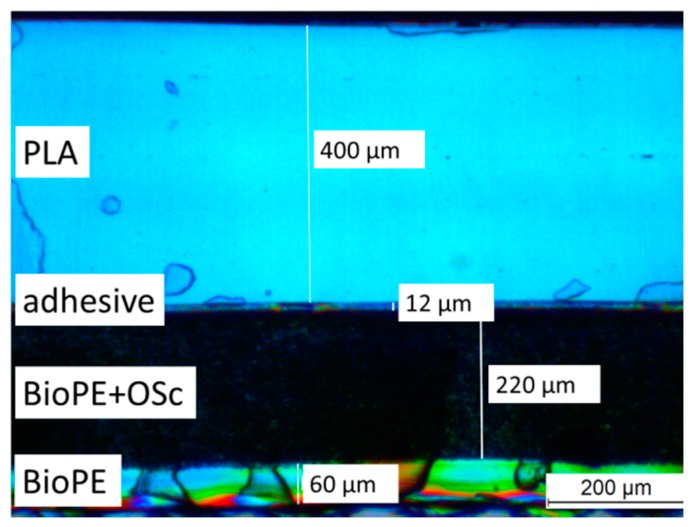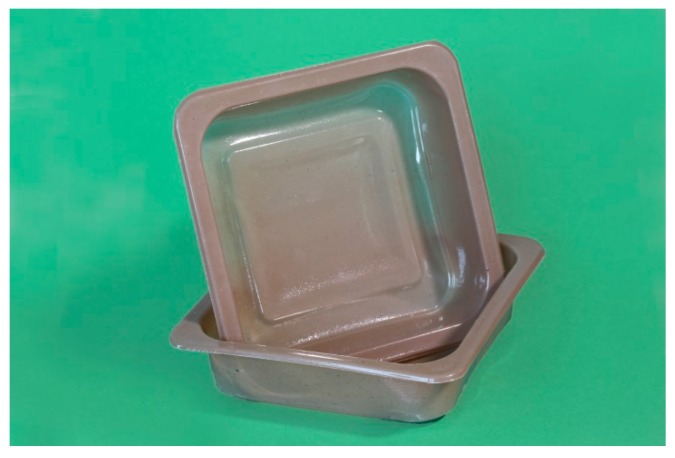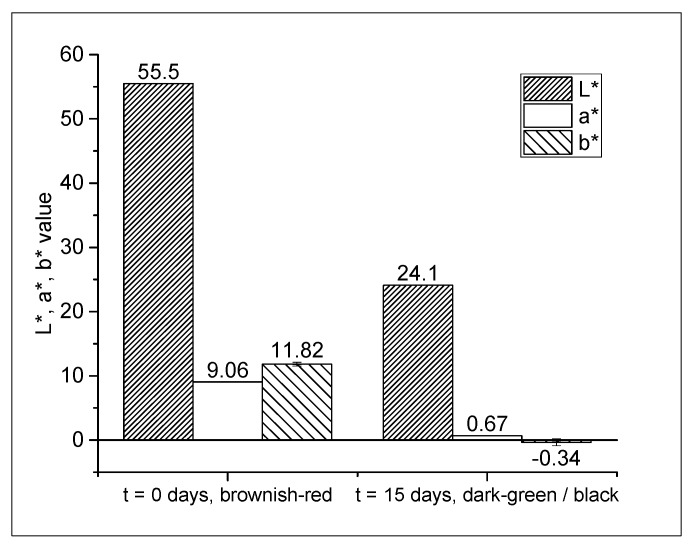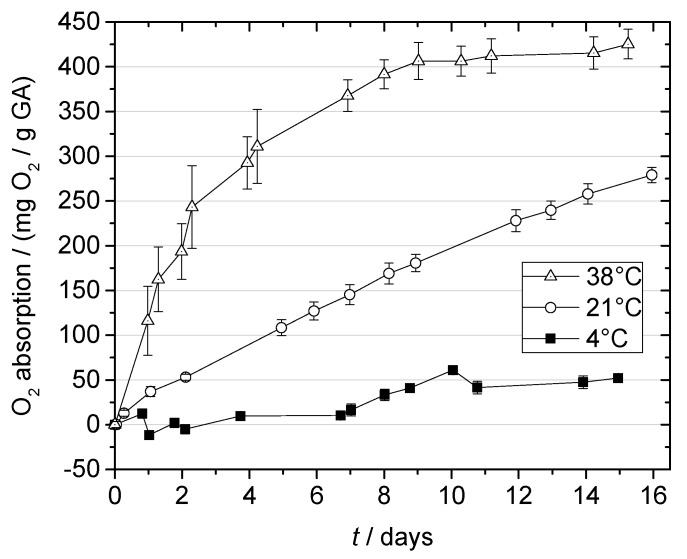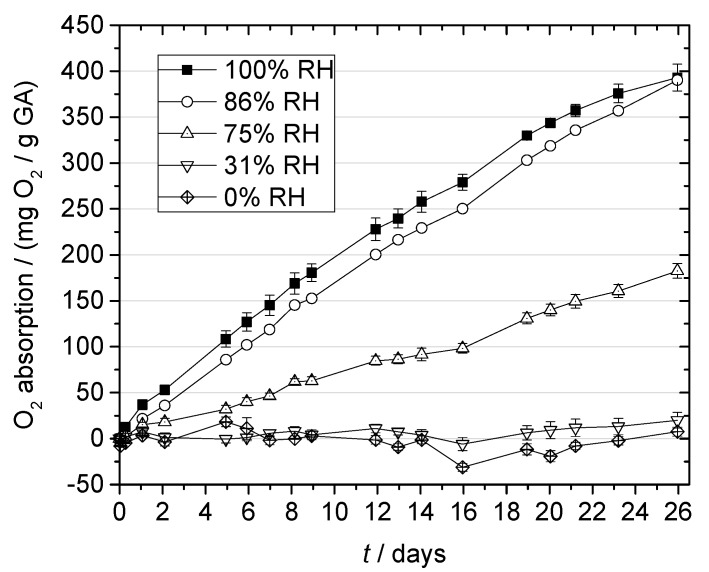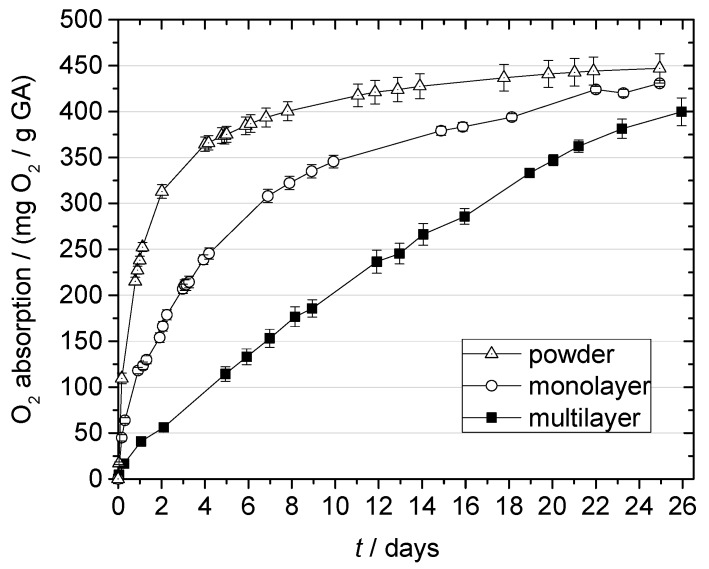Abstract
Oxygen scavengers are used in food packaging to protect oxygen-sensitive food products. A mixture of gallic acid (GA) and sodium carbonate was used as an oxygen scavenger (OSc) in bio-based multilayer packaging films produced in a three-step process: compounding, flat film extrusion, and lamination. We investigated the film surface color as well as oxygen absorption at different relative humidities (RHs) and temperatures, and compared the oxygen absorption of OSc powder, monolayer films, and multilayer films. The films were initially brownish-red in color but changed to greenish-black during oxygen absorption under humid conditions. We observed a maximum absorption capacity of 447 mg O2/g GA at 21 °C and 100% RH. The incorporation of GA into a polymer matrix reduced the rate of oxygen absorption compared to the GA powder because the polymer acted as a barrier to oxygen and water vapor diffusion. As expected, the temperature had a significant effect on the initial absorption rate of the multilayer films; the corresponding activation energy was 75.4 kJ/mol. Higher RH significantly increased the oxygen absorption rate. These results demonstrate for the first time the production and the properties of a bio-based multilayer packaging film with GA as the oxygen scavenger. Potential applications include the packaging of food products with high water activity (aw > 0.86).
Keywords: food packaging, absorber, active packaging, polyphenol
1. Introduction
In active packaging technology, oxygen (O2) scavengers are used to protect O2-sensitive food products [1,2,3]. Current examples include scavenger sachets, which are not common in Europe, and active packaging materials containing O2-scavenging substances in the polymer matrix [1,3]. Scavengers can also be classified according to their active substances, i.e., the substance that reacts with O2. Many commercially available scavengers are based on iron, oxidizable polymers, or sulfite [3,4,5,6,7].
Materials based on renewable resources support the development of sustainable packaging. Research has therefore focused on the development and improvement of bio-based packaging materials [8,9,10]. Some natural substances can be used as bio-based O2 scavengers including plant extracts, tocopherol, ascorbic acid, and especially polyphenols, which are known for their ability to react with O2 [11,12,13,14].
One polyphenol that is potentially suitable as an O2 scavenger for packaging applications is gallic acid (3,4,5-trihydroxybenzoic acid, GA) because it absorbs large amounts of O2 under alkaline conditions [13,15,16]. To provide alkaline conditions in the packaging material, GA must be combined with a base. Furthermore, the presence of water is required [13,16]. During the reaction between GA and O2, a change of color from white (pure GA) to dark brown, dark green, or black may be observed, depending on which base is used [13]. Therefore, GA was also proposed as an O2 indicator [13,16,17].
The incorporation of GA into packaging films has not been investigated in great detail. Langowski and Wanner first mentioned gallic acid as an O2 scavenger for packaging applications [16]. Goldhan et al. and Wanner described application trials, in which combinations of GA and different bases were integrated either in the adhesive layer or the coating of packaging films [13,17]. Recently, Ahn et al. reported the production of monolayer films containing GA and potassium carbonate [18]. However, the use of GA as a scavenger in packaging films requires multilayer structures comprising an outer O2 barrier layer to limit O2 ingress from the environment, and an inner food contact layer to prevent direct contact between GA and the packed food.
In this study, we describe the O2 absorption properties of bio-based packaging films containing GA as a natural O2 scavenger. Multilayer packaging films entirely based on renewable resources were produced in a three-step process involving compounding, cast film extrusion, and lamination. We investigated the effects of the polymer matrix, the relative humidity, and the temperature on oxygen absorption and determined the change in surface color caused by the reaction. The results provide insight into the O2 scavenging properties of GA and its potential applications in food packaging.
2. Results
2.1. Film Properties
A multilayer packaging film was produced in a pilot-scale three-step process involving compounding, cast film extrusion, and lamination. The film comprised a food contact layer (BioPE), an active layer containing the scavenger (BioPE + 15% (w/w) OSc), a bio-based adhesive, and an outer barrier layer (PLA) that reduces O2 ingress from the environment. The thicknesses of the individual layers of the produced film were determined in a microscopic analysis of the cross section and are given in Figure 1.
Figure 1.
The multilayer structure of the bio-based packaging film containing the gallic acid scavenger (OSc).
The film had a brownish red color after production with some small darker particles. These particles were most probably OSc powder agglomerates formed during processing. Powder agglomerates may affect the mechanical properties and barrier properties of the film. Thus, the process must be optimized in order to avoid agglomerates.
One potential application of the bio-based multilayer film is the production of O2-scavenging food packaging trays. In such a packaging setup, the main function of GA would be to scavenge residual O2 from the package headspace. Preliminary tests showed that the films can be thermoformed into trays (Figure 2). Future studies will therefore include storage tests with oxygen-sensitive food products to evaluate the GA-based scavenger under real packaging conditions.
Figure 2.
Thermoformed trays (144 mm × 144 mm × 40 mm) containing gallic acid as the O2 scavenger.
2.2. Film Color
The dry OSc mixture was white in color, but the first step of film production (compounding) resulted in light-purple compound pellets. This color change indicated that GA had reacted with O2 during the process. The multilayer film showed a darker brownish-red color, probably reflecting an additional reaction with O2. When stored under humid conditions, the film rapidly turned into a dark greenish-black (Figure 3), which is reflected by a decrease in L*, a*, and b* values.
Figure 3.
Multilayer film color after production (t = 0) and after storage at 21 °C and 100% RH (t = 15 days), expressed as CIE L*a*b* values.
Alkaline conditions promote a rapid reaction between GA and O2 and can be provided combining a basic substance and water [16]. This is reflected by the observed color changes during processing, which are slow under dry conditions but accelerate during storage at higher humidities. The color of polyphenols is determined by the presence of chromophoric groups that interact with light [14]. Dark reaction products of polyphenol oxidation, e.g., brown or black polycondensates, can be found in wine or humic substances [19,20]. The color change of the multilayer films indicated that GA formed larger molecules during the reaction with O2. Although these reaction products have not yet been characterized, they may represent dimers, as previously reported by Tulyathan et al. [15].
Remarkably, the observed color change was not proportional to the O2 absorption of GA. During the O2 absorption experiments (see Section 2.3), we noticed that the films continued absorbing O2 when the color had already turned into black, i.e., in the later stages of the reaction, the film color could not be related to the amount of O2 that was absorbed. This limits the O2-indicating function of GA to the first stages of the reaction. However, assessing the potential of GA as an O2 indicator requires further investigation of the correlation between color and O2 absorption.
2.3. Oxygen Absorption of Gallic Acid
O2 absorption was measured in closed cells with a defined initial O2 concentration of 20% (v/v) by monitoring the decrease in headspace O2 partial pressure over time. Varying storage conditions were used to determine the effect of temperature, relative humidity, and the polymer matrix on O2 absorption by GA. For better comparison, the results of the O2 absorption measurements are expressed as mg O2/g GA.
2.3.1. Effect of Temperature
The application temperature (i.e., the storage temperature of the packed product) is an important factor for the performance of O2 scavengers in terms of their absorption rate [7,21,22,23,24]. As described above, the O2 scavenging effect of GA relies on the chemical reaction of GA with oxygen. Therefore, a positive influence of temperature on the O2 absorption rate could be expected. We examined the O2 absorption by the produced multilayer films at 4, 21, and 38 °C during 16 days of storage. The results are presented in Figure 4. Higher storage temperatures led to increased O2 absorption; temperature had a significant effect on the initial reaction rate (p < 0.05).
Figure 4.
O2 absorption by gallic acid (GA) in multilayer films at 100% RH and varying temperatures.
The initial reaction rate constants kinit, obtained from the initial linear increase in O2 absorption, were 4.2 ± 0.6, 20.0 ± 0.5, and 124.0 ± 5.8 mg O2/(g GA d) for 4, 21, and 38 °C, respectively. This implies that O2 absorption in the beginning of the measurement was twice as high at 21 °C and 5 times higher at 38 °C compared to 4 °C.
In the linear fit of ln kinit vs. 1/T, Arrhenius-like behavior was observed (R2 > 0.99). The temperature-dependence of the initial rate constant kinit can therefore be described with the following equation:
The activation energy (Ea) of O2 absorption by the multilayer films was 75.4 kJ/mol. Lower Ea values in the range of 44.1 to 49.0 kJ/mol have been reported for commercially available iron-based scavengers [25,26]. Hence, for the analyzed films, the temperature has a greater effect on the GA-based scavenger than on the iron-based scavengers. The positive effect of temperature on the activity of the scavenger film can be explained as follows: The two main processes that determine O2 absorption of the scavenger film, O2 transport through the polymer matrix and the chemical reaction between O2 and GA, are both temperature-dependent and can be described by the Arrhenius law [27,28]. Therefore, the O2 absorption of the film is accelerated at higher temperatures.
These results reveal the influence of temperature on the performance of GA-based O2 scavengers and should therefore be taken into account for future applications.
2.3.2. Effect of Relative Humidity
Humidity, i.e., the availability of water, has been described as an important trigger of the scavenging reaction by GA [13,16,18]. The scavenging reaction is initiated by the deprotonation of GA in alkaline solution [29]. To enable this acid–base reaction in the produced multilayer films, humidity from the environment is needed. In our experiments, we determined the effect of RH on the O2 absorption by GA by storing multilayer films at 21 °C under different RH conditions (Figure 5). The RH conditions were chosen to simulate typical storage conditions for different types of food, characterized by different water activities (aw), i.e., dry powder products or cookies (31% RH), jam (75% RH), gammon or salami (86% RH), and beverages (100%) [22,30,31].
Figure 5.
O2 absorption by gallic acid (GA) incorporated in multilayer films at 21 °C and different relative humidities (RHs).
The amount of water present in the environment of the film significantly influenced O2 absorption by GA (p < 0.05). After 26 days, the samples stored at 100% or 86% RH achieved the highest absorption of ca. 390 mg O2/g GA, followed by those stored at 75% RH, which absorbed 185 mg O2/g GA. In comparison, storage at 31% or 0% RH resulted in negligibly low O2 absorption.
Remarkably, we found that the differences in O2 absorption were not proportional to the differences in RH. Higher RH led to a disproportionate increase in O2 absorption rate, whereas O2 absorption after 26 days was not significantly different at RH of 86% and 100% (p < 0.05). More research is therefore needed to characterize the influence of water on O2 scavenging by GA in more detail, and for quantitative analysis, a parameter other than RH may be required.
Overall, our results show that humid conditions are necessary for GA to scavenge O2 rapidly, and we therefore recommend GA for the packaging of moist products with water activities >0.86.
2.3.3. The Effect of Film Structure
The incorporation of GA into a polymer matrix led to a reduced O2 absorption, especially during the first few days of the reaction (Figure 6).
Figure 6.
O2 absorption by gallic acid (GA) in mono- and multilayer films and in powder form at 21 °C and 100% RH.
After 2 days, the OSc powder absorbed twice as much O2 as the monolayer films. As expected, this effect was even more pronounced in multilayer films. In the powder experiment, the maximum O2 absorption capacity of the GA scavenger was determined to be 447 ± 16 mg O2/g GA, and this was achieved after 25 days storage at 21 °C and 100% RH, after which the O2 absorption remained constant. The measured O2 absorption capacity is in line with the results of Wanner who reported an absorption capacity of 340 ± 7 cm3 O2/g GA for a GA-based scavenger at 25 °C, 100% RH, and 1013 hPa (equal to 445 mg O2/g GA) [13]. Ahn et al. observed a much lower maximum absorption capacity of app. 64 cm3 O2/g GA for GA combined with potassium carbonate in monolayer films stored at 23 °C and 95% RH [18]. However, this difference might be attributed to different processing conditions and film structures.
Compared to commercially available O2 scavengers, such as iron-based or polymer-based systems, GA shows a remarkably high absorption capacity. Table 1 gives an overview of the absorption capacities of different O2 scavengers. For a better comparison, O2 absorption is related to the amount of scavenger additive used, e.g., the amount of the OSc mixture in this study.
Table 1.
O2 absorption capacities of different O2 scavengers.
| Scavenger Type | Absorption Capacity mg O2/g Scavenger | References |
|---|---|---|
| OSc powder (gallic acid + sodium carbonate, 2:1) | 298 | this study |
| polymer additive with iron powder (SHELFPLUS® O2 2710) | 39–48 | [5] |
| polymer additive: copolyester-based polymer (Amosorb DFC 4020, Colormatrix Europe, Liverpool, UK) | 43–47 | [32] |
| polymer: ethylene methylacrylate cyclohexenylmethyl acrylate ‘OSP™’ | 60–100 | [23,33] |
| polymer: metal-catalysed poly(1,4-butadiene) | 140 | [34] |
| coating: cyclo-olefin bonded to a silicate backbone ‘ORMOCER®’ | 90 | [6] |
The monolayer and multilayer films absorbed 430 or 380 mg O2/g GA during the 25-day storage period but did not achieve their maximum absorption capacity due to their lower absorption rate (Figure 6). However, it seems like the film production process, which involved temperatures up to 220 °C, did not considerably reduce the O2 absorption capacity of GA compared to the untreated OSc powder.
The slower reaction of monolayer and multilayer films may reflect the gas barrier properties of the polymer matrix. Before the reaction with GA, the O2 must dissolve in the polymer and diffuse to the immobilized scavenger. The same applies for water vapor, which is also necessary for the reaction. Thus, the films can be regarded as complex reaction-diffusion systems. The reaction rate of such systems is determined by both the diffusivity of the reactants (O2 and water vapor) in the matrix and the rate constant for the actual scavenging reaction. The current research of our group focuses on developing a mathematical model that describes O2 scavenging films as a reaction–diffusion system, accounting for both O2 and water permeation. The aim is to get a deeper understanding of the underlying reaction mechanism, thereby providing further guidance for the design of tailor-made GA-based scavengers.
3. Materials and Methods
3.1. Materials
The scavenger (OSc) was obtained by blending gallic acid (GA) monohydrate powder (99%) and water-free sodium carbonate (Na2CO3), both from ABCR (Karlsruhe, Germany) at a ratio of 2:1. GA is a weak acid with the formula C6H2(OH)3COOH. At room temperature, it is a yellowish-white crystalline powder. At 253 °C, GA decomposes to form CO2 and pyrogallol [35].
A bio-based linear low-density polyethylene (BioPE, SLL218, Braskem, Brazil) served both as the polymer matrix for the OSc powder and as the food contact layer. BioPE was chosen due to its high O2 permeability (see Table 2) in order to allow for rapid oxygen transport from the packaging headspace to the embedded OSc particles.
Table 2.
Properties of the used polymers.
| Thermal Properties | Gas Permeability | ||||
|---|---|---|---|---|---|
| Polymer | Glass Transition Temperature °C | Melting Temperature °C | Crystallinity Degree % | O2 cm3 (STP) 100 µm/(m2 d bar) | H2O g 100 µm/(m2 d) |
| BioPE | n.d. | 125.6 | 24.6 | 1898 | 1 |
| PLA | 60.1 | 152.3 | 39.1 | 153 | 58 |
A 400 µm polylactide (PLA) film produced at Fraunhofer IVV (Freising, Germany) from PLA IngeoTM2003 D (Natureworks LLC, Minnetonka, MN, USA), served as an outer barrier layer for the packaging film.
For lamination, the bio-based adhesive EpotalR P100 ECO was mixed with 3% (w/w) hardener Basonat LR9056 (BASF SE, Ludwigshafen, Germany).
The thermal properties and the gas permeability of BioPE and PLA are given in Table 2.
The thermal properties were determined by differential scanning calorimetry (DSC) using a DSC 821e (Mettler-Toledo, Columbus, OH, USA) under a nitrogen atmosphere. Two heating runs (23 °C to 300 °C) were made with a heating rate of 10 K/min. The degree of crystallinity Xc was calculated by relating the determined melting enthalpy ∆ Hm to the theoretical melting enthalpy of 100% crystalline samples, which was taken to be 93.7 J/g (PLA) or 277.1 J/g (LDPE), respectively [36,37].
All gas permeation measurements were carried out on two replicate samples of 50 µm films.
O2 permeability was determined at 23 °C and 50% RH according to the DIN 53 380 standard method using an Oxtran device (Mocon, Brooklyn Park, MN, USA).
The water vapor transmission rates were determined according to DIN EN ISO 15106-3 with a Brugger device (WDDG, Brugger, Germany) at 23 °C and an 85–0% gradient of RH.
3.2. Film Production
3.2.1. Compounding
The OSc powder (15% (w/w)) was melt-blended with BioPE in a co-rotating twin screw extruder (Collin Teach-Line Bench Top Compounder ZK 25 T × 24 D; Dr. Collin GmbH, Ebersberg, Germany). The melt strain was then cooled on dry ice and pelletized (Pelletizer CSG 171 T; Dr. Collin GmbH). The temperature profile of the process comprised five zones at 20/100/125/115/120 °C. The rotational screw speed was 80 rpm, the melt pressure was 125 bar, and the melt temperature at the rod die was 160 °C. The BioPE-OSc compound was stored in hermetically sealed aluminum bags under a nitrogen atmosphere at 23 °C. The final concentrations of GA, Na2CO3, and BioPE in the compound were 10%, 5%, and 85% (w/w), respectively.
3.2.2. Cast Film Extrusion
Monolayer and multilayer cast films were produced on a flat film co-extrusion line (Dr. Collin GmbH) with a nozzle width of 300 mm.
Monolayer film: The BioPE-OSc compound was extruded by applying temperatures of 60/120/140/160/180/180 °C (zones 1–6) in an extruder with an L/D ratio of 30.
Multilayer film: An additional BioPE layer was co-extruded onto the monolayer film. The temperature profile in the extruder (L/D = 24) was 60/160/180/200/220 °C (Zones 1–5). The feedblock and nozzle temperatures were 200 °C and 220 °C, respectively.
3.2.3. Lamination
The co-extruded film was laminated to a 400 µm PLA film (lacquering and lamination pilot plant, Fraunhofer IVV, Freising, Germany). To improve surface properties, both films were Corona-discharge-treated beforehand. The adhesive was applied using a gravure roll.
The resulting laminate was packed in an aluminum bag under a nitrogen atmosphere. It was stored for 24 h at 50 °C to ensure complete hardening of the adhesive and thereafter stored at 23 °C.
3.2.4. Thermoforming
Samples of the bio-based multilayer films (ca. 650 cm2) were thermoformed into packaging trays using a semi-automatic thermoforming device (LDFG23B, Illig, Germany) in order to assess the potential of the film for thermoforming applications. The heating time was 12 s with a heating plate temperature of 520 °C. The moulding time was 6 s. The tray dimensions were 144 mm × 144 mm × 40 mm. In the present study, there was no further analysis of the trays.
3.3. Film Characterization
3.3.1. Layer Thickness
Microtome cut cross sections (20 µm) were obtained using a Jung Autocut 2055 (Leica, Wetzlar, Germany). Micrographs of these cross sections were made with a transmitted light microscope (Leitz GmbH, Wetzlar, Germany) and the thicknesses of the individual layers were determined using the corresponding microscope software (LAS V 4.0, Leica, Wetzlar, Germany).
3.3.2. Color Measurement
The surface color of the monolayer and multilayer films was analyzed before (t = 0) and after oxygen absorption (15 days at 21 °C and 100% RH) using the non-digital color imaging system DigiEye (DigiEye v2.62, VeriVide, UK). The system settings and calibration have been described by Böhner et al. [38]. Average surface color was determined from measurements of 10 points evenly distributed over the film surface and expressed as CIE L*a*b* values. In the CIE L*a*b color space, the L* axis gives the lightness. The a* axis represents the red/green opponent colors, and the b* axis represents the yellow/blue colors.
3.3.3. Oxygen Absorption
Film samples were stored in stainless steel cells equipped with two valves for gas flushing. For a detailed description, see Rieblinger et al. [39]. The cells were hermetically closed with a glass lid and had a free headspace volume of 86 cm3 or 106 cm3.
Relative humidity in the cells was adjusted with silica gel, calcium chloride, sodium chloride, potassium chloride, or water (0, 31, 75, 86, and 100% RH at 21 °C, respectively) [40,41,42].
The initial headspace gas atmosphere of 20% O2 and 80% N2 (v/v) was established by flushing the cell with synthetic air (Linde Gas, Munich, Germany). The decrease in the headspace O2 partial pressure (pO2) was then measured non-destructively during storage using Fibox 4 Trace, a luminescence-based oxygen detection system (PreSens Precision Sensing GmbH, Regensburg, Germany). For this, an optical sensor spot (PSt3) was placed inside the cell at the glass top.
The following samples were analyzed:
OSc powder: 0.06 g;
Monolayer: 0.25 g film: ~2.5 × 5 cm;
Multilayer: 0.96 g film ~2.5 × 5 cm.
All O2 absorption measurements were carried out on at least three replicate samples of films or powder, except for the measurement at 86% RH, for which only one replicate is available.
The results (decrease in pO2) were converted into the mass of absorbed O2 (mO2) using the ideal gas law: mO2 = (pO2 VHS MO2)/(R T), where VHS denotes the headspace volume of the cell, MO2 the molar mass of O2, R = 8.13446 J/(mol K) the ideal gas constant, and T is the temperature in Kelvin. For better comparison, mO2 was normalized to the mass of the GA contained in the film or in the scavenging powder, so all O2 absorption values are given in mg O2/g GA.
The initial rate constants of O2 absorption kinit/(mg O2/(g GA day)) were determined from the initial absorption values (up to 130 mg O2/g GA) by linear regression. In the initial phase of O2 absorption, the influence of the reactant concentrations on the reaction rate can be neglected so that this simplified approach of estimating kinit can be used.
The temperature dependence of kinit was analyzed by fitting the linearized form of the Arrhenius equation ln(k) = (−Ea/R)(1/T) + ln (A).
3.4. Data Treatment
OriginPro 2016G (OriginLab Corp., Northampton, MA, USA) was used for the analysis of the absorption data. The effect of treatments was examined in a one-way analysis of variance (ANOVA); the null hypothesis was rejected with a significance level of 0.05.
The presented results denote the arithmetic means of at least three replicate samples; error bars represent the standard deviation.
Acknowledgments
This research was part of the project “NextGenPack—Next generation of advanced active and intelligent bio-based packaging for food”. The authors would therefore like to acknowledge the funding by the Federal Ministry of Education and Research (BMBF, Germany) and the Agence nationale de la recherche (ANR, France) in the framework of the program “Programme Inter Carnot Fraunhofer PICF 2011”. This work was supported by the German Research Foundation (DFG) and the Technical University of Munich (TUM) in the framework of the Open Access Publishing Program. The authors would like to acknowledge the contributions of Julia Dorn, Michael Stenger, Tobias Brandner, Markus Pummer, and Brigitte Seifert for the production and analysis of the films.
Author Contributions
A.P. and S.S. conceived and designed the experiments, A.P. performed the experiments, A.P. and K.M. analyzed the data, S.S. and K.M. contributed analysis tools and expertise, and A.P. wrote the manuscript.
Conflicts of Interest
The authors declare no conflict of interest. The funding sponsors had no role in the design of the study; in the collection, analyses, or interpretation of data; in the writing of the manuscript; or in the decision to publish the results.
References
- 1.Singh P., Abas Wani A., Saengerlaub S. Active packaging of food products: Recent trends. Nutr. Food Sci. 2011;41:249–260. doi: 10.1108/00346651111151384. [DOI] [Google Scholar]
- 2.Realini C.E., Marcos B. Active and intelligent packaging systems for a modern society. Meat Sci. 2014;98:404–419. doi: 10.1016/j.meatsci.2014.06.031. [DOI] [PubMed] [Google Scholar]
- 3.Rooney M.L. Oxygen-scavenging packaging. In: Han J.H., editor. Innovations in Food Packaging. Elsevier Ltd.; San Diego, CA, USA: 2005. pp. 123–137. [Google Scholar]
- 4.Vermeiren L., Devlieghere F., van Beest M., de Kruijf N., Debevere J. Developments in the active packaging of foods. Trends Food Sci. Technol. 1999;10:77–86. doi: 10.1016/S0924-2244(99)00032-1. [DOI] [Google Scholar]
- 5.Lehner M., Schlemmer D., Sängerlaub S. Recycling of blends made of polypropylene and an iron-based oxygen scavenger—influence of multiple extrusions on the polymer stability and the oxygen absorption capacity. Polym. Degrad. Stab. 2015;122:122–132. doi: 10.1016/j.polymdegradstab.2015.10.020. [DOI] [Google Scholar]
- 6.Amberg-Schwab S., Weber U., Burger A., Nique S., Xalter R. Development of passive and active barrier coatings on the basis of inorganic–organic polymers. Monatsh. Chem. 2006;137:657–666. doi: 10.1007/s00706-006-0466-4. [DOI] [Google Scholar]
- 7.Müller K., Sängerlaub S., Kramer A., Huber C., Fritsch K. Temperature-dependent oxygen permeation through pet/mxd6-barrier blend bottles with and without oxygen absorber. BrewingScience. 2011;64:161–167. [Google Scholar]
- 8.Hu Z., Hong P., Liao M., Kong S., Huang N., Ou C., Li S. Preparation and characterization of chitosan—Agarose composite films. Materials. 2016;9:816. doi: 10.3390/ma9100816. [DOI] [PMC free article] [PubMed] [Google Scholar]
- 9.Schmid M., Hinz L.-V., Wild F., Noller K. Effects of hydrolysed whey proteins on the techno-functional characteristics of whey protein-based films. Materials. 2013;6:927–940. doi: 10.3390/ma6030927. [DOI] [PMC free article] [PubMed] [Google Scholar]
- 10.Nurul Fazita M.R., Jayaraman K., Bhattacharyya D., Mohamad Haafiz M.K., Saurabh C., Hussin M., H.P.S. A.K. Green composites made of bamboo fabric and poly (lactic) acid for packaging applications—A review. Materials. 2016;9:435. doi: 10.3390/ma9060435. [DOI] [PMC free article] [PubMed] [Google Scholar]
- 11.Scarfato P., Avallone E., Galdi M.R., Di Maio L., Incarnato L. Preparation, characterization, and oxygen scavenging capacity of biodegradable α-tocopherol/pla microparticles for active food packaging applications. Polym. Compos. 2015 doi: 10.1002/pc.23661. [DOI] [Google Scholar]
- 12.Janjarasskul T., Min S.C., Krochta J.M. Triggering mechanisms for oxygen-scavenging function of ascorbic acid-incorporated whey protein isolate films. J. Sci. Food Agric. 2013;93:2939–2944. doi: 10.1002/jsfa.6120. [DOI] [PubMed] [Google Scholar]
- 13.Wanner G.T. Ph.D. Thesis. Technische Universität München; München, Germany: 2010. [(accessed on 2 May 2017)]. O2-zehrende und -anzeigende Packstoffe für Lebensmittelverpackungen. Available online: https://mediatum.ub.tum.de/doc/972162/document.pdf. [Google Scholar]
- 14.Shahidi F., Naczk M. Phenolics in Food and Nutraceuticals. CRC Press; Boca Raton, FL, USA: 2003. [Google Scholar]
- 15.Tulyathan V., Boulton R.B., Singleton V.L. Oxygen uptake by gallic acid as a model for similar reactions in wines. J. Agric. Food Chem. 1989;37:844–849. doi: 10.1021/jf00088a002. [DOI] [Google Scholar]
- 16.Langowski H.-C., Wanner T. Organic Oxygen Scavenger/Indicator. 2007059901. WO Patent. 2005
- 17.Goldhan G., Wanner T., Saengerlaub S., Amberg-Schwab S., Weber U., Nique S. Enhancement and indication of food quality by combinations of oxygen scavenger and indicator systems. Ital. J. Food Sci. 2007;19:157–164. [Google Scholar]
- 18.Ahn B.J., Gaikwad K.K., Lee Y.S. Characterization and properties of ldpe film with gallic-acid-based oxygen scavenging system useful as a functional packaging material. J. Appl. Polym. Sci. 2016;133 doi: 10.1002/app.44138. [DOI] [Google Scholar]
- 19.Oliveira C.M., Ferreira A.C.S., De Freitas V., Silva A.M.S. Oxidation mechanisms occurring in wines. Food Res. Int. 2011;44:1115–1126. doi: 10.1016/j.foodres.2011.03.050. [DOI] [Google Scholar]
- 20.Kumada K. Studies on the colour of humic acids. Soil Sci. Plant Nutr. 1965;11:11–16. doi: 10.1080/00380768.1965.10433805. [DOI] [Google Scholar]
- 21.Galotto M.J., Anfossi S., Guarda A., Guarda A. Oxygen Absorption Kinetics of Sheets and Films Containing a Commercial Iron-based Oxygen Scavenger. Food Sci. Technol. Int. 2007;15:159–168. doi: 10.1177/1082013208106207. [DOI] [Google Scholar]
- 22.Gibis D., Rieblinger K. Oxygen scavenging films for food application. Procedia Food Sci. 2011;1:229–234. doi: 10.1016/j.profoo.2011.09.036. [DOI] [Google Scholar]
- 23.Solis J.A., Rodgers B.D. Factors affecting the performance of new oxygen scavenging polymer for packaging applications. J. Plast. Film Sheet. 2001;17:339–349. doi: 10.1106/22AM-UVR8-X89X-7WBO. [DOI] [Google Scholar]
- 24.Polyakov V.A., Miltz J. Modeling of the temperature effect on oxygen absorption by iron-based oxygen scavengers. J. Food Sci. 2016;81:E76–E85. doi: 10.1111/1750-3841.13148. [DOI] [PubMed] [Google Scholar]
- 25.Charles F., Sanchez J., Gontard N. Absorption kinetics of oxygen and carbon dioxide scavengers as part of active modified atmosphere packaging. J. Food Eng. 2006;72:1–7. doi: 10.1016/j.jfoodeng.2004.11.006. [DOI] [Google Scholar]
- 26.Tewari G., Jayas D.S., Jeremiah L.E., Holley R.A. Absorption kinetics of oxygen scavengers. Int. J. Food Sci. Technol. 2002;37:209–217. doi: 10.1046/j.1365-2621.2002.00558.x. [DOI] [Google Scholar]
- 27.Langowski H.-C. Permeation of gases and condensable substances through monolayer and multilayer structures. In: Piringer O.G., Baner A.L., editors. Plastic Packaging. Wiley-VCH Verlag GmbH & Co. KGaA; Weinheim, Germany: 2008. pp. 297–347. [Google Scholar]
- 28.Atkins P., Paula J.d. Atkins’s Physical Chemistry. 9th ed. Oxford University Press; Oxford, UK: 2010. [Google Scholar]
- 29.Marino T., Galano A., Russo N. Radical scavenging ability of gallic acid toward oh and ooh radicals. Reaction mechanism and rate constants from the density functional theory. J. Phys. Chem. B. 2014;118:10380–10389. doi: 10.1021/jp505589b. [DOI] [PubMed] [Google Scholar]
- 30.Sängerlaub S., Gibis D., Kirchhoff E., Tittjung M., Schmid M., Müller K. Compensation of pinhole defects in food packages by application of iron-based oxygen scavenging multilayer films. Packag. Technol. Sci. 2013;26:17–30. doi: 10.1002/pts.1962. [DOI] [Google Scholar]
- 31.Kessler H.-G. Trockenprodukte - sorptionsisothermen - haltbarkeit. In: Kessler H.-G., editor. Lebensmittel- Und Bioverfahrenstechnik: Molkereitechnologie; Mit 109 Tabellen. 4th ed. Kessler; München, Germany: 1996. pp. 255–264. [Google Scholar]
- 32.Di Maio L., Scarfato P., Galdi M.R., Incarnato L. Development and oxygen scavenging performance of three-layer active pet films for food packaging. J. Appl. Polym. Sci. 2014;132 doi: 10.1002/app.41465. [DOI] [Google Scholar]
- 33.Ching T.Y., Goodrich J., CAI K., Yang H. Tasteless oxygen scavenging polymers a new platform technology for food packaging based on controlled oxidation; Proceedings of the Oxygen Absorbers 2001 and Beyond; Chicago, IL, USA. 9–26 June 2000. [Google Scholar]
- 34.Li H., Ashcraft D.K., Freeman B.D., Stewart M.E., Jank M.K., Clark T.R. Non-invasive headspace measurement for characterizing oxygen-scavenging in polymers. Polymer. 2008;49:4541–4545. doi: 10.1016/j.polymer.2008.07.061. [DOI] [Google Scholar]
- 35.Beyer H., Walter W. Lehrbuch der Organischen Chemie, 22., Überarbeitete Und Aktualisierte Auflage. S. Hirzel Verlag, Stuttgart; Stuttgart, Germany: 1991. [Google Scholar]
- 36.Grulke E.A., Immergut E., Brandrup J. Polymer Handbook. John Wiley & Sons; Hoboken, NJ, USA: 1999. [Google Scholar]
- 37.Garlotta D. A literature review of poly(lactic acid) J. Polym. Environ. 2001;9:63–84. doi: 10.1023/A:1020200822435. [DOI] [Google Scholar]
- 38.Böhner N., Rieblinger K. Impact of different visible light spectra on oxygen absorption and surface discoloration of bologna sausage. Meat Sci. 2016;121:207–209. doi: 10.1016/j.meatsci.2016.06.019. [DOI] [PubMed] [Google Scholar]
- 39.Rieblinger K., Ziegleder G., Berghammer A., Sandmeier D. Verfahren und Vorrichtung zur Bestimmung der Haltbarkeit von Lebensmitteln und Dessen Verwendung. 19528400 c1. DE Patent. 1996
- 40.Greenspan L. Humidity fixed points of binary saturated aqueous solutions. J. Res. Natl. Bur. Stand Sect. A Phys. Chem. 1977;81:89–96. doi: 10.6028/jres.081A.011. [DOI] [Google Scholar]
- 41.Wexler A. Practical laboratory data. In: Lide D.R., editor. Crc Handbook of Chemistry and Physics 1998–1999. 79th ed. CRC Press; Boca Raton, FL, USA: 1998. pp. 25–26. Section 15. [Google Scholar]
- 42.Budavari S. Constant humidity solutions. In: Budavari S., editor. The Merck Index an Encyclopedia of Chemical, Drugs, and Biologicals. 11th ed. Merck & Co.; Rahway, NJ, USA: 1989. p. MISC–109. [Google Scholar]



